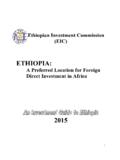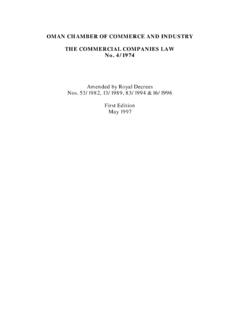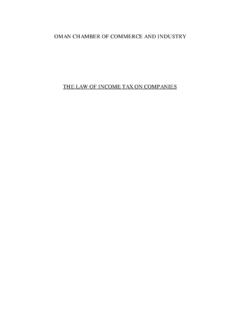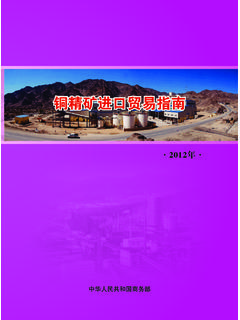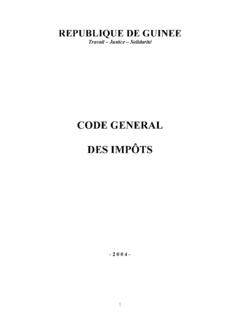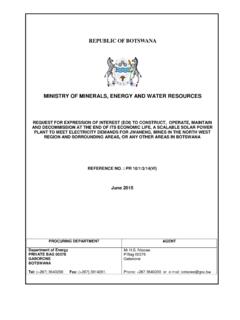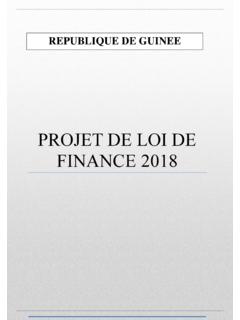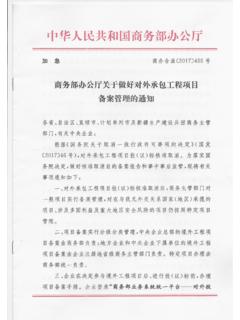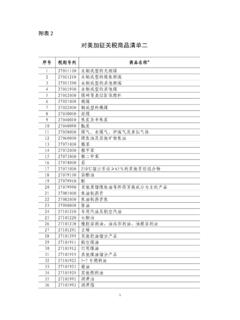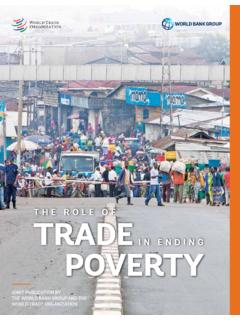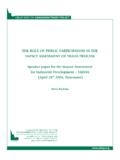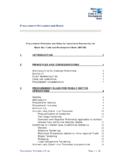Transcription of TH EDITION A World Bank Group Flagship Report …
1 Equal Opportunity for AllA World bank Group Flagship ReportDoing BusinessComparing business Regulation for Domestic Firms in 190 Economies201714TH EDITION 2017 International bank for Reconstruction and Development / The World Bank1818 H Street NW, Washington DC 20433 Telephone: 202-473-1000; Internet: rights reserved1 2 3 4 19 18 17 16 This work is a product of the staff of The World bank with external contributions. The findings, interpretations, and conclusions expressed in this work do not necessarily reflect the views of The World bank , its Board of Executive Directors, or the governments they represent. The World bank does not guarantee the accuracy of the data included in this work. The boundaries, colors, denominations, and other information shown on any map in this work do not imply any judgment on the part of The World bank concerning the legal status of any territory or the endorsement or acceptance of such herein shall constitute or be considered to be a limitation upon or waiver of the privileges and immunities of The World bank , all of which are specifically and PermissionsThis work is available under the Creative Commons Attribution IGO license (CC BY IGO) Under the Creative Commons Attribution license, you are free to copy, distribute, transmit, and adapt this work, including for commercial purposes, under the following conditions:Attribution Please cite the work as follows: World bank .
2 2017. doing business 2017: Equal Opportunity for All. Washington, DC: World bank . DOI: License: Creative Commons Attribution CC BY IGOT ranslations If you create a translation of this work, please add the following disclaimer along with the attribution: This translation was not created by The World bank and should not be considered an official World bank translation. The World bank shall not be liable for any content or error in this If you create an adaptation of this work, please add the following disclaimer along with the attribution: This is an adaptation of an original work by The World bank . Views and opinions expressed in the adaptation are the sole responsibility of the author or authors of the adaptation and are not endorsed by The World content The World bank does not necessarily own each component of the content contained within the work. The World bank therefore does not warrant that the use of any third-party-owned individual component or part contained in the work will not infringe on the rights of those third parties.
3 The risk of claims resulting from such infringement rests solely with you. If you wish to re-use a component of the work, it is your responsibility to determine whether permission is needed for that re-use and to obtain permission from the copyright owner. Examples of components can include, but are not limited to, tables, figures, or queries on rights and licenses should be addressed to World bank Publications, The World bank Group , 1818 H Street NW, Washington, DC 20433, USA; fax: 202-522-2625; e-mail: (paper): 978-1-4648-0948-4 ISBN (electronic): 978-1-4648-0984-2 DOI: : 1729-2638 Cover design: Corporate Visions, business REGULATION FOR DOMESTIC FIRMS IN 190 ECONOMIES A World bank Group Flagship ReportDoing business 2017 Equal Opportunity for All14TH EDITIOND oing business 2017 Resources on the doing business websiteCurrent featuresNews on the doing business project RankingsHow economies rank from 1 to 190 DataAll the data for 190 economies topic rankings, indicator values, lists of regulatory procedures and details underlying indicators Reports Access to doing business reports as well as subnational and regional reports.
4 Case studies and customized economy and regional profiles Methodology The methodologies and research papers underlying doing business of papers on doing Businesstopics and related policy issues doing business reforms Short summaries of DB2017 business regulation reforms and lists of reforms since DB2006 Historical dataCustomized data sets since DB2004 Law libraryOnline collection of business laws and regulations relating to business than 12,500 specialists in 190 economies who participate in doing business / doing -businessEntrepreneurship dataData on new business density (number of newly registered companies per 1,000 working-age people) for 136 economies /exploretopics/entrepreneurshipDistance to frontierData benchmarking 190 economies to the frontier in regulatory practice and a distance to frontier calculator /data/distance-to-frontierInformation on good practicesShowing where the many good practices identified by doing business have been adopted /good-practiceDoing business 2017 iv Foreword 1 Overview 13 About doing business 25 Reforming the business Environment in 2015/16 Case studies 44 Getting ElectricityFactors affecting the reliability of electricity supply 52 Getting Credit: Legal RightsTwo approaches to developing an integrated secured transactions regime 58 Getting Credit.
5 Credit Information Casting a wide net to expand financial inclusion 65 Protecting Minority InvestorsAchieving sound corporate governance 72 Paying TaxesAssessing postfiling processes 79 Trading Across BordersTechnology gains in trade facilitation 87 Annex: Labor Market Regulation What can we learn from doing business data? 96 Annex: Selling to the Government Why public procurement matters 102 References 114 Data Notes 164 Distance to Frontier and Ease of doing business Ranking 170 Summaries of doing business Reforms in 2015/16 188 Country Tables 252 Labor Market Regulation Data 272 AcknowledgmentsContents doing business 2017 is the 14th in a series of annual reports investigating the regulations that enhance business activity and those that constrain it. doing business presents quantitative indicators on business regulation and the protection of property rights that can be compared across 190 economies from Afghanistan to Zimbabwe and over time.
6 doing business measures aspects of regulation affecting 11 areas of the life of a business . Ten of these areas are included in this year s ranking on the ease of doing business : starting a business , dealing with construction permits, getting electricity, registering property, getting credit, protecting minority investors, paying taxes, trading across borders, enforcing contracts, and resolving insolvency. doing business also measures features of labor market regulation, which is not included in the ranking. Data in doing business 2017 are current as of June 1, 2016. The indicators are used to analyze economic outcomes and identify what reforms of business regulation have worked, where and business 2017 ForewordNow in its 14th EDITION , the doing business Report demonstrates the power of a simple idea: measure and Report the actual effect of a govern-ment the summer of 1983, a Group of researchers working with Hernando de Soto got all the permits required to open a small garment business on the outskirts of Lima, Peru.
7 Their goal was to measure how long this took. I read de Soto s book, The Other Path, decades ago, but I was so astonished by the answer it reported that I remember it today: 289 days. De Soto s conjecture, which turned out to be right, was that measuring and Report -ing would create pressure for improve-ments in the efficiency of government. In the foreword to the revised EDITION of his book that he wrote in 2002, de Soto reports that because of changes to regu-lations and procedures, the same busi-ness could get all the required permits in a single day. In a letter published in the Winter 2006 issue of the Journal of Economic Perspectives, Simeon Djankov describes how de Soto s idea grew into this Report . When Joseph Stiglitz was the World bank Chief Economist, he selected the topic and picked the team for The World Development Report 2002: Building Institutions for Markets.
8 Djankov, who was a member of this team, reached out to Andrei Shleifer, a professor at Harvard, who had done research on the effects that different legal systems had on market development. Shleifer and co-authors agreed to work on some background papers for the World Development Report that would examine new data on such processes as getting the permits to start a new business that could be compared across countries. In 2003, this data collection effort yielded the first doing business Report , which presented five indicators for 133 countries. The doing business Report has had the same effect on policy in many economies that de Soto s initial effort had in Peru. In 2005, it was possible to get the permits to start a business in less than 20 days in only 41 economies. In 2016, this is possi-ble in 130 economies.
9 This history should give us the optimism and impatience to keep launching new ideas and to keep striving for better results. The progress to date should give us optimism. The large amount that remains to be done should make us impatient. doing business 2017 highlights the large disparities between high- and low-income economies and the higher barriers that women face to starting a business or getting a job compared to men. In 155 economies women do not have the same legal rights as men, much less the sup-porting environment that is vital to pro-mote business 2017 gives prominence to these issues, expanding three indicators starting a business , registering property and enforcing contracts to account for gen-der discriminatory practices. But why the gender focus?Research shows that gender gaps exist in women s access to economic oppor-tunities.
10 While women represent of the World s population, they account VFOREWORDfor only of the formal workforce. In emerging markets between 31 and 38% of formal small and medium-size enterprises have at least one woman owner, but their average growth rate is significantly lower than that of male-owned Gender gaps in women s entrepreneurship and labor force par-ticipation account for an estimated total income loss of 27% in the Middle East and North Africa, a 19% loss in South Asia, a 14% loss in Latin America and the Caribbean and a 10% loss in Globally, if all women were to be excluded from the labor force income per capita would be reduced by almost 40%.4To capture ways in which governments set additional hurdles for women entre-preneurs, doing business 2017 considers for the first time a number of gender-specific scenarios.
